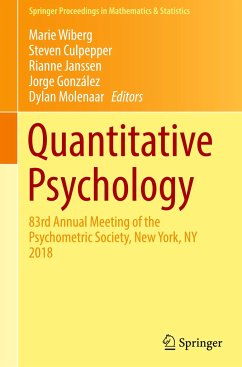
Quantitative Psychology
84th Annual Meeting of the Psychometric Society, Santiago, Chile, 2019
Herausgegeben: Wiberg, Marie; Molenaar, Dylan; González, Jorge; Böckenholt, Ulf; Kim, Jee-Seon

PAYBACK Punkte
57 °P sammeln!
This proceedings volume highlights the latest research and developments in psychometrics and statistics. It represents selected and peer reviewed presentations given at the 84th Annual International Meeting of the Psychometric Society (IMPS), organized by Pontificia Universidad Católica de Chile and held in Santiago, Chile during July 15th to 19th, 2019.The IMPS is one of the largest international meetings on quantitative measurement in education, psychology and the social sciences. It draws approximately 500 participants from around the world, featuring paper and poster presentations, sympos...
This proceedings volume highlights the latest research and developments in psychometrics and statistics. It represents selected and peer reviewed presentations given at the 84th Annual International Meeting of the Psychometric Society (IMPS), organized by Pontificia Universidad Católica de Chile and held in Santiago, Chile during July 15th to 19th, 2019.
The IMPS is one of the largest international meetings on quantitative measurement in education, psychology and the social sciences. It draws approximately 500 participants from around the world, featuring paper and poster presentations, symposiums, workshops, keynotes, and invited presentations.
Leading experts and promising young researchers have written the included chapters. The chapters address a large variety of topics including but not limited to item response theory, multistage adaptive testing, and cognitive diagnostic models. This volume is the 8th in a series of recent volumes to cover research presented at the IMPS.
The IMPS is one of the largest international meetings on quantitative measurement in education, psychology and the social sciences. It draws approximately 500 participants from around the world, featuring paper and poster presentations, symposiums, workshops, keynotes, and invited presentations.
Leading experts and promising young researchers have written the included chapters. The chapters address a large variety of topics including but not limited to item response theory, multistage adaptive testing, and cognitive diagnostic models. This volume is the 8th in a series of recent volumes to cover research presented at the IMPS.














